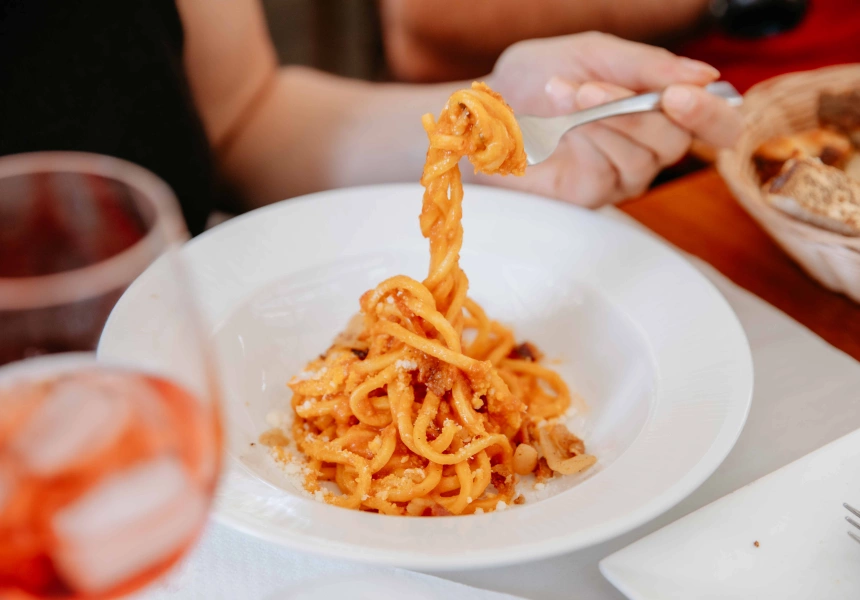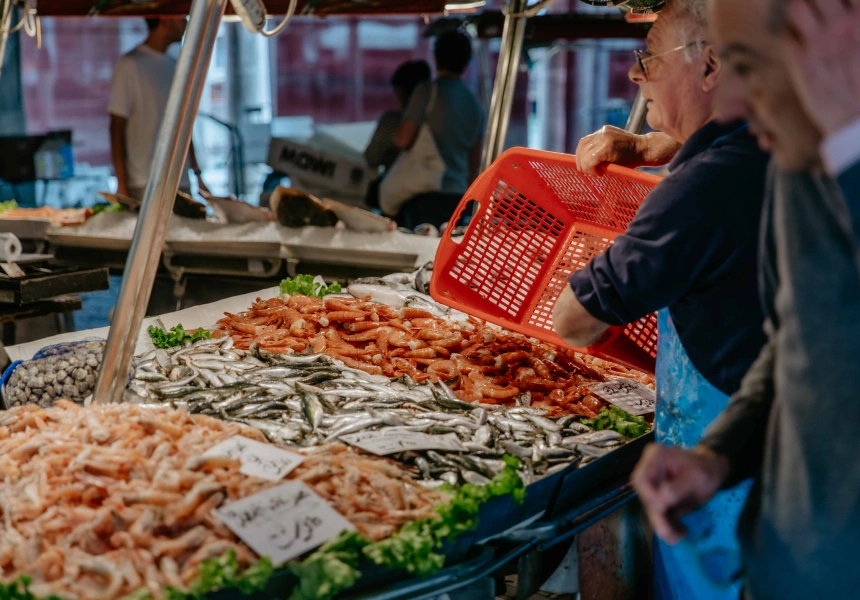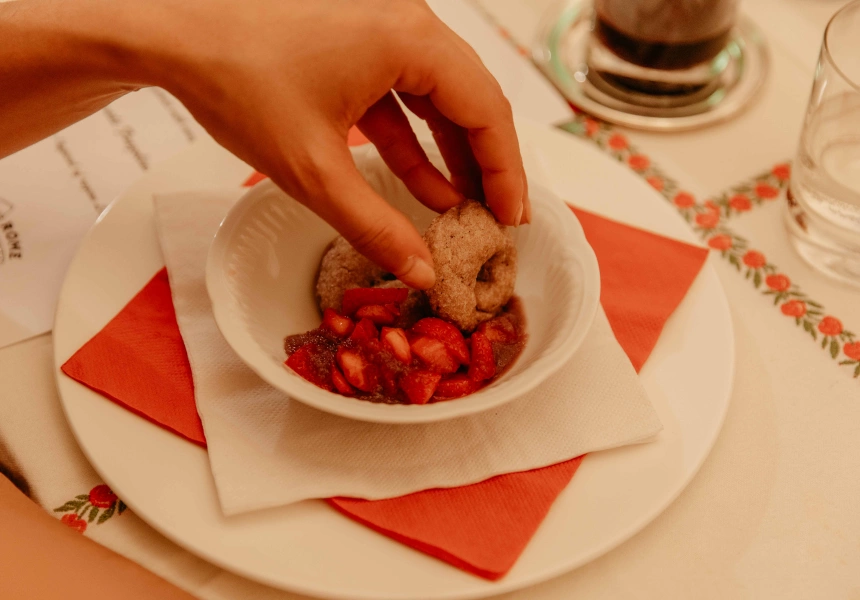“What you have around the table is heritage, it’s culture, it’s not just food. It’s art for us,” declares our enthusiastic Intrepid leader, Matteo.
The Italian native has guided our intimate tour group – comprised of two Canadian couples; solo travellers from the United States, Canada and Melbourne; Broadsheet photographer Kate Shanasy; and me – to a small bacaro, or wine bar, in Dorsoduro, Venice’s laid-back university district. After sampling some classic cicchetti (Venetian aperitivi, or tapas) with wine, our local guide begins his lesson on Italian food culture – we’re on Intrepid’s Italy Real Food Adventure, after all.
Matteo talks our group through some culinary dos and don’ts (parmesan on seafood is a no-no; never crack spaghetti in half; don’t twirl it with a spoon, either; and “god forbid” you use a knife and fork); the act of la scarpetta (mopping up every last bit on your plate with your bread); and how to spot good gelato (pistachio and banana should be brownish, never bright green or yellow – that’s artificial colouring).
Never miss a moment. Make sure you're subscribed to our newsletter today.
SUBSCRIBE NOWMatteo then relays the culinary specialties of each region we’ll be visiting over the next few days. For the uninitiated, Italian cuisine varies wildly across the country: from rich, meaty dishes made with rice, polenta or fresh egg pasta in the north, to the “cucina povera” of the south, made with legumes, vegetables, seafood and dried wheat pasta. The chilli factor increases as you get closer to the Mediterranean, too. The common thread between regions is the inextricable link between local food and identity, which is why you’ll see denominations of origin like DOP, DOC and IGP all over the country, protecting regional products from imitators. Bologna, widely considered the culinary capital of Italy, has even registered its famous ragu with the chamber of commerce.
In short, what you eat in Italy depends on where you eat. Here’s how to do it like the locals.
Venice
You can’t walk more than a few steps along the canals of Venice without passing a bacaro serving cicchetti. The bite-sized snacks are all over the floating city, usually in the form of crostini or polenta topped with cheese, cured meats or fish – most notably baccala mantecato (whipped salted cod) and sarde in saor (sardines in a sweet and sour onion dressing). They’re always paired with wine, colloquially known as ombra or “shadows”. Seafood is an anchor of Venetian cuisine, owing to the Adriatic Sea and a historic fish market just steps from the Grand Canal. Our group samples some of it at a local trattoria in the Cannaregio district, diving into spaghetti with scampi, mussels, clams and octopus, and a super light risotto laced with tiny prawns and fresh zucchini.
If you’re after a Venetian breakfast, expect something sweet – plain and filled croissants, flaky foldovers and other golden pastries – alongside your cappuccino. “This is how they start their day in Venice,” Matteo tells us, as I dutifully devour a danish with lemon cream. We finish the day with a classic Venetian dessert, the “original” tiramisu, which is a slightly richer, thicker version made without booze, chocolate or egg whites.
Bologna
In a country this revered for its cuisine, it’s a big deal that Italy’s Emilia-Romagna region is known as the country’s food bowl, famous for its production of cured meats like prosciutto di Parma and mortadella, hard cheeses like Parmigiano-Reggiano and Grana Padano, and stuffed egg pastas like tortellini (typically filled with meats and added to brodo) and its larger sibling, cheese-filled tortelloni. It’s little wonder Bologna, the capital, is nicknamed The Fat.
The region’s also known for its trademark tagliatelle – silky ribbons of pasta served with the world-renowned ragu you might know as bolognaise – plus pillowy gnocco fritto and rich, aged balsamic vinegar of Modena, so prized it’s known as “black gold”. With the help of Matteo, our tour group somehow manages to eat all of the above in just 24 hours in Emilia-Romagna, washed down with local lambrusco, a light, sparkling red wine that’s even added to the risotto here, staining it red.
Florence
There are a lot of cows outside of Florence, Matteo tells us, which explains why we’re seeing so much leather and beef in the Tuscan capital. Our enthusiastic Intrepid leader has added an impromptu stop in Florence to our itinerary, much to our delight, before we hop on a train to an agriturismo, a working farm in the lush Tuscan countryside. We’re here to try some of that beef, specifically the local specialty bistecca alla Fiorentina. The enormous cut of meat, which comes from Chianina cows (a Tuscan breed named for the Chianti region it’s from), is essentially a giant T-bone with a strip steak (fillet) on one side and a boneless tenderloin on the other. It’s a size fit to be shared, so we split two between the 10 of us.
Our classic Florentine meal also includes Tuscan bread, which is made without salt (apparently, historically, local bakers couldn’t afford the introduction of a salt tax) and famously bland, although it has a nice chewy texture. Plus, crunchy almond biscotti dipped in sweet vin santo wine – a typical end to any good Tuscan meal. The next day in San Gimignano, a medieval village an hour’s drive south of Florence, we try two more local specialties: ribollita, a thick bread and vegetable soup; and fat, chewy pappardelle with a rich wild boar sauce.
Rome
When in Rome, eat carbonara. Or cacio e pepe. Or amatriciana. The trio of pastas are everywhere in the Eternal City, all showered in funky, salty pecorino romano. Matteo was born and raised in Rome, so when we arrive he leads us to a trattoria frequented by locals, evinced by the suits and priests waiting for a table, to sample each one. Other Roman specialties include pasta alla gricia, which is a little like carbonara without the eggs; deep-fried Roman artichokes, which originated in Rome’s Jewish quarter; trippa alla Romana, or tripe cooked in tomato sauce; and crispy, fatty, slow-roasted porchetta, stuffed into bread rolls with zero frills or garnishes.
It’s all very delicious and very rich, so we’re ending our time in Rome (and our Intrepid tour) with a home-cooked, plant-based dinner at a local nonna’s house. After courses of panzanella salad, gnocchi and stuffed tomatoes, we finish on another Roman specialty: ciambelline, crunchy doughnut-shaped biscuits made with red wine. They’re so good I bought a bag of them to take back home to Australia alongside my real-deal balsamic vinegar of Modena and many, many food memories.
This article is produced by Broadsheet in partnership with Intrepid Travel. Intrepid’s Italy Real Food Adventure tour is a fully guided eight-day trip that includes all transport and accommodation. Starting in Venice and finishing in Rome, it includes a stay in a traditional Tuscan farmhouse, a cooking class in Bologna and a visit to a Parmigiano Reggiano cheese factory. Find out more here.*




